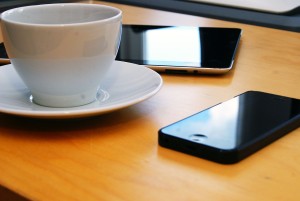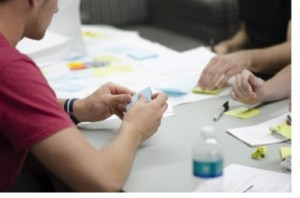Your meeting room leaves a large carbon footprint, and not just because large groups of people drive and occasionally fly to get to them. The way you use your conference room technology — in particular your audio visual setup — can also have an impact on your energy consumption.
Here are four ways to make your meeting room greener using technology:
1. Upgrade Your Tech
Start by making sure that your meeting room has energy efficient devices, AV equipment, and fixtures. Use LED lights and properly insulated windows. Make sure that it’s easily accessible to most of your employees. For example, if your meeting room is on one floor and the majority of your employees are on another, they’ll use elevators to move between floors, leading to more energy consumed. Plan the physical location of your rooms carefully. Perhaps you can have large windows that let in natural light, instead of relying on artificial ones for your meetings.
2. Go Wireless
Without cables and wires, you’re already consuming less energy. By using a wireless projection system and other wireless energy-star rated devices, you don’t waste time connecting devices to the audio visual setup and not too much energy is consumed during the meeting either.
This also ensures that you don’t need to have a dedicated set of hardware for your meeting rooms. By using wireless technology, you can easily utilize your devices in different rooms. For example, you don’t need two different sets of telecommunications equipment, devices, and presentation equipment for two different meeting rooms if you can make do with one.

3. Go Paperless (i.e. Digital)
Paper brochures, meeting reading material, nametags, etc, only add to the carbon footprint. If you’re going wireless, you can easily go paperless. All you need to do is have the right presentation software and a way to connect to all of the individual devices of people attending the meeting.
You can also send all reading materials to your audience well in advance so that they can read it on their wireless devices. Paperless meetings are becoming increasingly common. You don’t need to print several copies of the literature, wasting paper, and ink. This cuts cost across the board.
4. Connect Remotely
One way to reduce the environmental impact of your meeting room is to connect with people remotely. Instead of forcing people from other states or countries to fly in for the meeting, connect with your team members with remote presentation. With the right communication and productivity tools, you can share your presentation with anyone, anywhere. All you need to do is give them the right access.
If you set up your meeting with video-conferencing tools, you can give remote audiences live, interactive access to your presentation. This significantly reduces the environmental impact of your meetings.
A trend that starts with your meeting room’s audio visual setup can spread throughout your company. Eventually, you’ll start becoming environmentally responsible in your day-to-day life. It’s vital to start somewhere, no matter how small you think your contribution would be.
Want to set up a wireless Conference Room?Try Now
Don't miss a Story.
Want to set up a wireless Conference Room?Try Now
Conference room technology and AV equipment have grown leaps and bounds in recent years. They have changed the way we communicate in the workplace, amongst ourselves, across departments, and across the globe. That shift has set expectations for more immediate collaboration and conversation during meetings. This is why the wireless presentation system has become one of the most in-demand conference room AV products of the BYOD era.
Wireless presentation systems turn meeting rooms into central access points for content. Through secured environments, team members can meet in one digital location from various physical locations and multiple devices. Wireless presentations turn the meeting room into a collaborative place where content can be shared through any pre-existing audio visual setup.
Wireless presentations turn meeting rooms into a central access point for content. Through secured environments, team members can meet in one location from various locations and multiple devices. Wireless presentations turn the meeting room into a collaborative place with shareable content and readily available means of communication.
So, why go with Ubiq over anyone else? Ubiq’s wireless presentation system is an all-in-one solution that provides a cable free, hassle free, seamless experience for meetings and conferences. Built around the concept of hives, Ubiq’s hardware resides in the center of your meeting room, connecting people to content across multiple devices and (soon) remote locations.
Here are just some of the benefits:
- Easy set-up. Ubiq has designed the system for self set-up and provides step-by-step instructions. Ubiq’s wireless presentation system integrates with your current IT infrastructure. It works with the A/V technology you currently use. The hardware, also known as a “hive,” only needs to be set up in center of your meeting room. The system is supported by PC and Mac operating systems, and will be compatible with multiple tablets and mobile devices (coming soon).
- Quick access. Wireless presentations can be activated and accessed in under 10 seconds. Using P2P and WiFi connectivity, it takes a few simple clicks to enter your meeting session in and out of the conference room. Remote presentations will allow for your virtual teams to share in the experience in real-time, creating greater communication and collaborative opportunities.
- Time. Ubiq not only is easy to use, but it promotes productivity. Integrating with calendar tools, like Google Calendar, teams can schedule meetings, reserve rooms and request “hive” access. It sets structure around meeting organization for all parties involved.
- Security. Ubiq works with your enterprise security structure and policies. It can bridge corporate and guest networks to allow all key parties to partake in the same session. Live session data is encrypted and protected to only be accessed through the designated meeting with the hive. Ubiq also supports corporate SSO (single sign-on) to create a simple authentication process through Ubiq’s software.
- Less strain on IT. Ubiq is user-friendly. It is meant to empower employees to set-up their own meetings using easy to manage technology with minimal IT involvement. IT can spend their time more efficiently to support your company in other areas. Ubiq also provides an administrative dashboard for monitoring of “hive” activity from a single, remote location. IT does not need to be in the room, and can be proactive in making sure all systems are a-go!
Discover how Ubiq can work for your organization. Request a demo today!
Don't miss a Story.
Want to set up a wireless Conference Room?Try Now
The way we conduct meetings has changed over the years, thanks to technology. From the telephone to video to the interactive display, meeting rooms and huddle spaces are no longer bound to location and time zones. The tools we use have certainly evolved to help us be more productive, efficient, and collaborative.
Let’s look at how conference room technology has grown:
Telephone conferencing. Alexander Graham-Bell’s telephone in 1877 changed how we communicate from remote locations. Business meetings didn’t need to be in the same room. No need to wait for messages to arrive via telegraph or post. He brought real-time communication!
Since then, we’ve seen the telephone’s purpose change thanks to innovations, such as:
- The speakerphone allowed groups to speak through a single 1:1 communication flow.
- Conference functionality allowed a user to connect more than one phone line to another or transfer to another.
- Conference call systems opened communication to allow multiple phones to connect into a single line.
WATCH: “The Birth of Telecommunications” (History)
Video conferencing added a visual element to work communication. People could see and speak to one another. Video initially was an enhancement to audio. Since then, it flipped with the rise of the Internet and cloud connectivity.
Video communication has changed how we see, hear, and speak with one another. Tools like Skype, Facetime, Google Hangouts and WebEx gives us options to record or live stream our conversations. All the while, we make our business portable and social.
VIEW: “The History of Videoconferencing” (Telemerge, Inc./SlideShare)
Where are we today? The wireless presentation has bridged the gap between teleconferencing and videoconferencing. It has promoted unified communication to allow teams to connect across different platforms, devices, and audio visual setups. It’s changing company cultures by bringing people together through a central access point.
We’re able to contribute and bring value to our meetings no matter our location.
WATCH: “Get Started with Ubiq”
Where do we go next? Take a look at what Lightpath put together in a great timeline infographic on “The Evolution of the Business Meeting.”
Tell us where you see conference room technology and conference room AV equipment are heading!
Don't miss a Story.
Want to set up a wireless Conference Room?Try Now
The average rate of productivity in the workplace is said to have improved slightly in the past year, according to the Department of Labor (DoL). However, many organizations are still challenged in this area. For instance, another survey by Salary.com found that 89 percent of employees waste time each day, with some losing at least 30 minutes by doing non-related work tasks.
When it comes to increasing worker efficiency, several factors from health and sleep patterns to office design and desk plants have been said to influence it. Year over year though, a few hacks have continued to prove effective in boosting office productivity.
1. Take Control of Technology
Several studies have shown that technology can boost worker productivity, but only when used effectively. One example of effective technology usage is to save time. For example, implementing wireless presentation software can open up time that was once wasted on setting up meetings, implementing digital signage that sends your conference room calendar to all of your interactive displays can help increase meeting room attendance, and using video conferencing can save you from traveling across the globe.
The key is to guide and control how certain technologies are used to create engagement and avoid distraction. For example, online collaboration tools allow workers to share, proofread, and edit projects in real-time from anywhere, accelerating the entire process. However, relying on them too much or using them unnecessarily can decrease efficiency. Organizations need to find the balance that works best for them.

2. Set Performance Goals and Track them
One basic factor that can hurt productivity is that employees simply don’t know what is expected from them. When organizations give their employees specific, clear and realistic goals, it can help boost motivation and competition. This is especially true when individuals are rewarded or recognized publicly for meeting and exceeding goals. In fact, not recognizing achievement is the number one reason that people leave their jobs. Companies can even increase engagement by tracking and gamifying performance milestones. Several online applications and programs like GamEffective can help track productivity and transform it into a game or employee engagement tools like OfficeVibe, that can engage your employees in less than 5 minutes a month.
3. Measure Productivity Consistently
Every business is unique, which means that not every productivity tool or policy will produce substantial results. This is one reason why establishing a consistent method of measurement is essential.
Another, perhaps more important reason, is that it creates the opportunity for company leaders to give employees meaningful feedback and to receive feedback from them. Measuring efficiency in your office should be designed in a way that helps employees grow personally and professionally.
4. Let them Work from Home, Occasionally
The Harvard Business Review published results from a study on Chinese travel company, Ctrip’s remote workers. The company compared the efficiency of employees allowed to work from home to in-office employees for a nine month period. It found that the at-home workers made 13.5 percent more calls per week on average than their in-office counterparts.
The study claimed that giving employees a break from the daily monotony of their workstations, meeting rooms, and huddle spaces can actually boost happiness and productivity. It wasn’t that the at-home group worked harder than the on-site one. It was all about having flexibility. Maintaining a healthy balance between on-site and remote options can increase overall performance.
Employees are the driving force behind every organization’s success. With so many devices and gadgets, they can easily lose focus and fall behind. Organizations that take control of their office environment and engage workers are the ones that will maintain increased productivity and growth year after year.

Don't miss a Story.
Want to set up a wireless Conference Room?Try Now
A top concern for CIOs, CEOs, and IT personnel is the leaking of sensitive or proprietary information revealed during exclusive meetings. Now that everyone owns a mobile device and data breaches are on the rise (up 40 percent last year), information security in meeting rooms is even more difficult to maintain.
Ensuring that your data is safe before, during, and after meetings is crucial for any organization, especially for those in government, healthcare, and technology sectors. Below are some tips for ensuring that your meeting rooms are under lock and key.
1. Control preparation materials
When preparing materials for a presentation or conference, limit the use of physical data as much as possible. In many cases, losing or leaking physical data can be more likely due to the lack of control. If you are using collaboration tools or software to pull together figures, graphics, and presentations, make sure that it is with a secure provider and only select individuals have access to it. If it’s online, never use an insecure network or public Wi-FI.
2. Assess the space
One of the best ways to ensure your meeting rooms are secure is to assess them beforehand. If it is located in your office space or another entity that you control, this is easier to accomplish. If it is located elsewhere, try to do a security walkthrough before the event. Get to know the security staff and any meeting policies.

3. Using wireless presentation systems
It is easier to limit possible security leaks if you own or control the meeting space. But oftentimes, you may need to present at other locations off-site with another company’s AV equipment. In these instances, using a wireless presentation system can allow you to upload data straight from your device to any pre-existing audio visual setup. This limits the access points and narrows the chance of a breach.

4. Verify attendees
For bigger meetings, having a list of approved participants is key. Some may go as far as giving each attendee an ID badge or other mode of identification to ensure that only select individuals are allowed in. This can prevent any competitors or leaks from entering, and it can track participants in case one does occur.
5. Brief participants
Before beginning a meeting that may contain restricted information, quickly inform participants. Let them know that it is sensitive, give them a tip sheet on how to protect data after the meeting ends, or have them sign a short, to-the-point contract regarding the release of information and responsibilities.

6. Restrict the devices used
Another threat to security in meeting rooms is the use of mobile devices. In a Ponemon Institute study, leakage of information was the top risk of insecure mobile devices. In some cases, restricting the use of a smartphone, tablet or any mobile device, can be extremely difficult to impossible, especially when it comes to larger events. However, you can still ask participants to refrain from using these devices during all or some restricted parts of the meeting. Personnel can help monitor the room and enforce the rule when a meeting is in session.
In an age where everyone has a smartphone camera or recording device, it can be difficult to keep sensitive information released in meetings a secret for long. However, companies can take control of the situation and increase security with these best practices.

Don't miss a Story.
Want to set up a wireless Conference Room?Try Now
Stepping inside a meeting room can feel a lot like stepping inside a black hole: Once you’ve moved beyond the event horizon (i.e. the conference room door), the possibility of escaping within a human lifetime can seem extremely remote. Even huddle spaces — the meeting room’s younger, less time-draining sibling — have a well-documented tendency to hold whoever steps inside them captive for extremely long durations against their will.
But contrary to popular opinion, it is at least theoretically possible for groups of people to set foot inside meeting rooms or huddle spaces and re-emerge within just 30 minutes. Here are 4 ways to help accomplish this:
- Create a To-Do List. A to-do list will help you keep track of the meeting. Being able to check off tasks can help to build motivation and to maintain your focus. Our recommendation would be to create your to-do list for all meetings so you know actually what needs to be done for each person of the team. It’ll give you the opportunity to evaluate your performance and make adjustments in your meeting approach. It will also prepare you for what’s to come.
- Time Your Agenda. Your to-do list can help promote time management – which you will know what to speed up and what to slow down. Use your calendar, like Google or Outlook, to send out the agenda prior to the meeting. With Ubiq, you can send your calendar to your conference room TV or interactive displays prior to the meeting to make such that all of the attendees are on the same page. Reserve time to dedicate to projects and tasks, while setting your own expectations for timely completion.
- Set Yourself as “Do Not Disturb.” Many of us still get emails, and instant messages during meeting time. The reason for this is because we feel that we can do multiple things at once including replying back to emails or instant messages, and feel the need to reply back. The truth is that many emails can wait, and setting yourself as do not disturb can be a lot more efficient during meetings. Recently, I was in making a wireless presentation during a meeting. However, while I was making a wireless presentation, there were notifications that popped up from my email and instant messaging. One of the emails that I received was from my sister asking me what to eat for dinner. If I set myself as do not disturb, those wouldn’t pop up. Additionally, I would avoid the embarrassment of people reading my emails or messages.
- Delegate, When Necessary. It doesn’t hurt to ask for support of others when you need it. That’s the whole point of meetings. Discuss all the problems and best practices with your team. That way, everyone can benefit and sharing stories make meetings go a bit more bearable. When you want to achieve all your goals in meetings, delegate tasks to your peers or have shared tasks. Discussing key problems and delegation can help achieve goals in meetings and create more wins to the team.
- Implement a Wireless Presentation System. Every meeting in which users are forced to connect their laptops to the TV or projector with wires or adapters inevitably goes 15 minutes over schedule due to connectivity problems. By investing in a wireless presentation system that allows users to connect their laptop to any audio visual setup regardless of its video outputs, all of this wasted time can easily be avoided.
With fewer distractions and proper delegation of work, you can give proper attention in meetings, which leads to an increase in teamwork and productivity. The challenge comes in how you manage our time and efforts independently and collaboratively. These tips should set you on the right path to getting the most out of your meeting rooms and huddle spaces.
